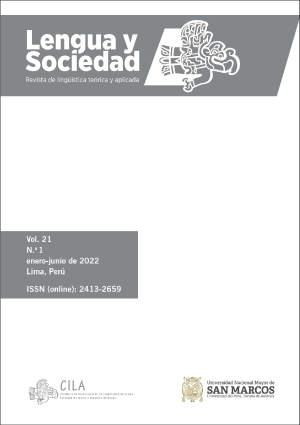Value-added offer on Spanich Websites from Translation and Language Service Providers
DOI:
https://doi.org/10.15381/lengsoc.v21i1.23089Keywords:
Translation service provider, language service provider, value-added services, management typeAbstract
The main objective of this empirical applied and documental study was to identify value-added services offered on web pages of translation service providers and language service providers in Spanish language speaking countries. The sample of this study comprised 169 web pages of translation service providers and language service providers. The analysis was made using the contents analysis technique, while data coding/tabulation was made using the SPSS software. The research arrived at the following general conclusions: 1. Both translation service providers and language service providers offer value-added services related to seven types of management: language, editorial, translation, audiovisual translation, contents, events, and computer-assisted translation; the services with the greatest offer are audiovisual translation management and language management; 2. Companies are the suppliers offering the highest number and diversity of value-added services; and 3. The countries with the largest offer of value-added services in the Spanish speaking world, in rank order, are Spain, Colombia and Peru.
References
AENOR (2006). UNE-EN 15038-2006. Servicios de traducción. Requisitos para los servicios de traducción. España.
Arellano, R. (2010). Marketing: Enfoque América Latina. Editorial Pearson.
Arevalillo, J. J. (2012). Postedició, canvi de paradigma? Revista Tradumática: tecnologies de la traducció, 10, 185-191. https://dialnet.unirioja.es/servlet/articulo?codigo=4976928
Biel, L. (2011). Training translators or translation service providers? EN 15038:2006 standard of translation services and its training implications. The Journal of Specialised Translation, (16), 61-76.
Canales, S. y Llontop, Z. (2004). Estudio del mercado real y potencial de las industrias del lenguaje en la ciudad de Cajamarca [Tesis de licenciatura, Universidad Femenina del Sagrado Corazón]. https://goo.gl/Rit1oa
Clavijo, B, Panqueva, M., Correal, M., Duque, M., Mendoza, E., Franco, C. y Galindo, J. (2006). Necesidad de la traducción en las empresas. Procesos y perfiles. Revista EAN, (58), 61-78. https://doi.org/10.21158/01208160.n58.2006.387
FIT (2017). Language Industry Survey. Expectations Concerns at the European Language Industries. https://shortest.link/2hGB
Gieure, C. (2016). El traductor e intérprete emprendedor: análisis de la supervivencia de las empresas y los empresarios autónomos [Tesis doctoral, Universidad de Alicante]. RUA. http://hdl.handle.net/10045/55629
Gouadec, D. (2007). Translation as a Profession. John Benjamins.
Kuznik, A. (2010). El contenido de los puestos de trabajo de los traductores. El caso de los traductores internos en las empresas de traducción de Barcelona [Tesis doctoral]. TDX. http://hdl.handle.net/10803/5279
Kuznik, A. (2011). Puestos de trabajo híbridos. Cuatro indicadores del carácter heterogéneo de los puestos de trabajo internos en traducción. Sendebar, 22, 283-307. https://doi.org/10.30827/sendebar.v22i0.355
Lovedock, C. y Wirtz, J. (2009). Marketing de servicios. Personal, tecnología y estrategia. Pearson Education.
Lozano, C. (2011). Estudio de Mercado sobre la Traducción en España. Salamanca.
Luna, R. (2015). Salidas profesionales de los Egresados de Traducción e Interpretación (Lima-Perú). Facultad de Lenguas Modernas. Universidad Ricardo Palma. Lima: Perú.
Luna, R. y Monteagudo, M. (2017). Diccionario para profesionales de la traducción. Terminología básica que todo traductor debe aprender. Universidad de Ciencias Aplicadas.
Martínez, O. (2011). La nueva dimensión de los servicios empresariales y personales de traducción y traducción empresarial. Universidad EAN. https://doi.org/10.21158/9789588153902
Martínez, S. (2015). Situación de la oferta y la demanda de la traducción e interpretación en el sector minero peruano [Tesis de licenciatura, Universidad Femenina del Sagrado Corazón]. Repositorio Institucional UNIFÉ. http://hdl.handle.net/20.500.11955/249
Navas, C. y Palomares, R. (2002). An Approach of the Spanish Translation. Xanadu. http://foreignword.com/Articles/Palomares/default.htm
Rosas, J. y otros (2014). Submercados de la Escuela Profesional de Traducción e Interpretación de la FHLM de la Universidad Ricardo Palma. FHLM.
Seminario, F. (2002). La traducción con relación a la oferta y la demanda en la ciudad de Chiclayo. [Tesis de licenciatura]. UNIFE. https://goo.gl/6kvLGS
Terry, R. (2021). Los problemas de reexpresión en la traducción hacia la lengua materna. Lengua y Sociedad, 20(2), 333-358. https://doi.org/10.15381/lengsoc.v20i2.22256
Yuste, E. (2012). La posedición en el flujo de producción de contenido multilingüe: tendencias, actantes e implicaciones tecnológicas. Tradumática, (10), 157-165. https://ddd.uab.cat/pub/tradumatica/tradumatica_a2012n10/tradumatica_a2012n10p157.pdf
Downloads
Published
Issue
Section
License
Copyright (c) 2022 Rosa Luna García

This work is licensed under a Creative Commons Attribution 4.0 International License.
AUTHORS RETAIN THEIR RIGHTS
a. Authors retain their trade mark rights and patent, and also on any process or procedure described in the article.
b. Authors can submit to the journal Lengua y Sociedad, papers disseminated as pre-print in repositories. This should be made known in the cover letter.
c. Authors retain their right to share, copy, distribute, perform and publicly communicate their article (eg, to place their article in an institutional repository or publish it in a book), with an acknowledgment of its initial publication in the journal Lengua y Sociedad.
d. Authors retain theirs right to make a subsequent publication of their work, to use the article or any part thereof (eg a compilation of his papers, lecture notes, thesis, or a book), always indicating its initial publication in the journal Lengua y Sociedad (the originator of the work, journal, volume, number and date).






